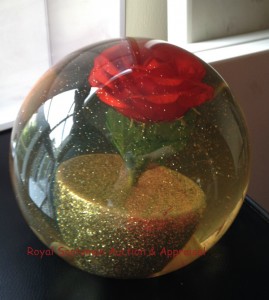Greetings Royal Friends and Followers,
I think the number one, most frequently asked question we hear is, “What’s it worth?” or “is this worth anything?” Sometimes the question comes from another perspective, such as “I was told this was worth a lot of money.” In that particular case the item holder was relieved to hear that the item was worth less than $100, because she loved it and wanted to use it. This really is the bottom line isn’t it folks? Value is such a relative term. How does my burly Royal Scotsman answer the question? Usually with another question! It’s complicated, because there really isn’t a single, one time answer! We have a mantra that you will hear repeated throughout these pages. Just because it’s old, doesn’t mean it’s really valuable; and just because it’s new doesn’t mean it has little value!
The folks at for Dummies use the term R.A.D.A.R., for Rarity, Aesthetics, Desirability, Authenticity, and Really great condition. This easy to remember term is intended primarily to apply to antiques, but may work for just about any item.
Items that were mass produced tend to command less value. Even if the item is fairly old, if there are a fair few to be had, it just won’t bring the big bucks. Items produced as collectibles often fall into this category. Collector plates, so expensive to purchase new, and once touted as an investment, no longer command much over a few dollars in most cases.
If most people think it’s attractive, it will probably command a higher value than something that is largely a matter of personal taste. An example we encountered at one of our estate sales was a bowling ball. Yup, you heard me correctly. Now I’ve seen bowling balls used as garden ornaments, and some very creatively, but usually they tend to end up in the “donate” box at the end of a sale. There are just too many out there, and it is something you need to have a use for. This particular ball, however, fetched a handsome price. Not because it was rare, because it was really attractive! Even people who didn’t bowl stopped to look at this one.
You might recognize this one from the movie “Kingpin” with Bill Murray. Not old, and not really rare, but really cool!
Cycles of popularity or desirability change. Victorian and Country Primitive styles were once extremely hot and commanded top dollar. Now, Mid Century Modern is a top dollar earner. Some items and some periods will consistently hold a higher price, for example, Arts and Crafts Era items tend to hold stable and fairly strong prices.
Just because it’s old, doesn’t mean it’s really valuable; and just because it’s new doesn’t mean it has little value!
Some items become so popular that they are reproduced, and this is one you will really need to be alert to! If you are buying from an estate, the seller may not know the items’ history, so it will be up to you to know the authentic thing! I will cover this topic in greater depth in our Reproductions and Fakes sections, so stay tuned.
When values are determined for sale, (auction, estate sale, liquidation, or retail) the asking or expected price may be affected by a number of variables. Value of the item for sale is affected by how much time the holder has to deal with the item. If there is a need to clear a house, or auction an item at a lien sale, the item will simply not command as high a price as it would if it could sit until someone agreed to the asking price. Of course many of you already know that most items command a higher price on the first day of an estate sale than they do on the last day! Ultimately the value is determined by how much a buyer is willing to pay on any given day. This is why you will often see auction estimates quoted as a range rather than a specific price. This is also the reason that most estate sale prices are negotiable.
Finally, the condition the item is in will have an effect on it’s value. An item in like new condition, regardless of it’s age, will command a higher price than one with any damage. In most cases, even minor damage can reduce the value by about half.
I would be remiss if I didn’t at least mention insurance value. Most insurance appraisals will place value on an item by the cost to replace the item. An insurance value is usually for an item the holder is not intending to sell, so tends to be higher than an appraisal with the intent of immediate liquidation. If a claim is made, a replacement item may be difficult to locate, or the cost may have risen, so again, an insurance value will tend to be higher. This is why most appraisers certify values for two years. If the item is worth insuring, it is certainly wise to stay current on its’ value!
We have been asked how we determine value for an estate sale, and the simple version of this is that we try to price to make collectors happy, and to leave some wiggle room for someone buying for resale. Our responsibility is to the owner, and we always do our best to maximize the estate, while also clearing out the space!
For more information on value, stay tuned to this page, because I will be adding to it periodically. You can also find more information on our website, in the frequently asked questions.
Ta Ta for now,
Her Sparkling Majesty, Queen Michele

